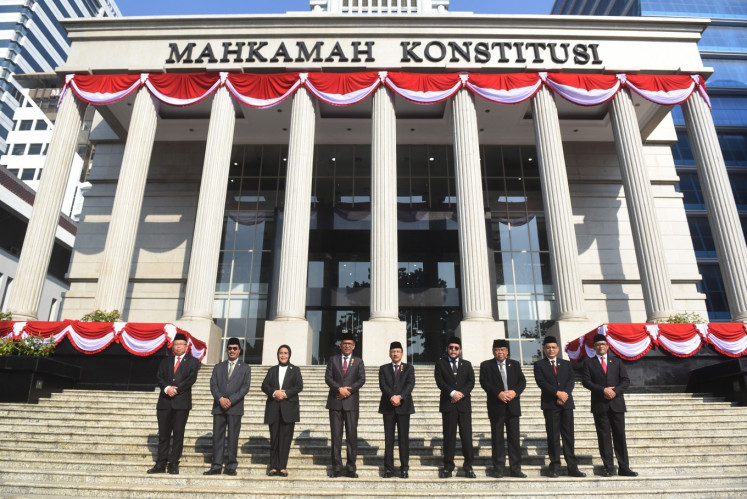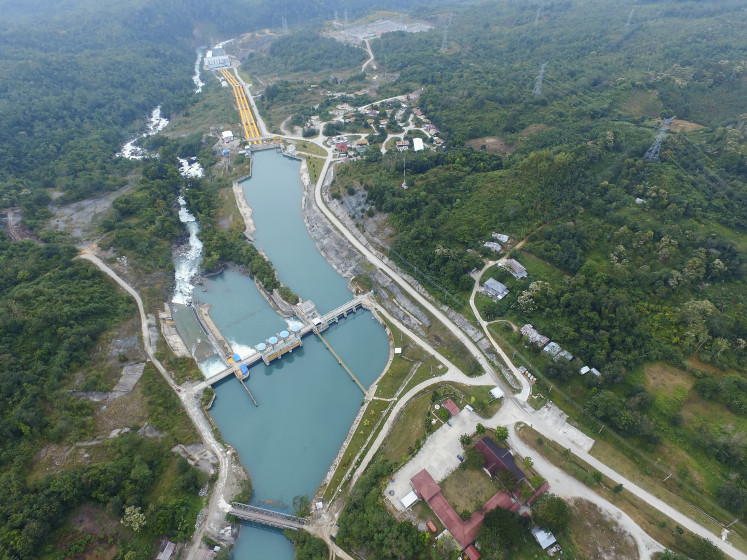Popular Reads
Top Results
Can't find what you're looking for?
View all search resultsPopular Reads
Top Results
Can't find what you're looking for?
View all search resultsTurning scale to value is essential for companies in Indonesia in post-pandemic world
COVID-19 has accelerated the adoption of digital health and emerging economies like Indonesia have the potential to reinvent care delivery and lead on digital health solutions.
Change text size
Gift Premium Articles
to Anyone
 Protect and serve: Shop attendants wear face shields at a shopping mall in Serpong in Tangerang, Banten. Shopping malls have applied strict health protocols to protect against COVID-19. (JP/R. Berto Wedhatama)
Protect and serve: Shop attendants wear face shields at a shopping mall in Serpong in Tangerang, Banten. Shopping malls have applied strict health protocols to protect against COVID-19. (JP/R. Berto Wedhatama)
A
s Asia grapples with the impact of COVID-19, the region’s top corporate executives are deeply concerned about the impact on business performance and livelihoods in a volatile post- pandemic environment. For many of Asia’s largest companies, this complicates the underperformance challenge they were already facing pre-COVID-19.
Over the past decade, the region’s corporate giants have grown rapidly in scale. Asia today is home to 43 percent of the world’s largest 5,000 companies by revenue (G5000), with Indonesia represented by 36 companies.
But scale has not translated to value. Between 2005-2007 and 2015-2017, economic profit generated by Asia’s largest companies fell from US$150 billion to a loss of $207 billion.
Nearly half of this decline is due to a cyclical downturn in the energy and materials sectors. Another third can be explained by the allocation of capital to value-destroying sectors, particularly in China. The remainder of the decline is due to the underperformance of Asian firms.
When we measured the G5000 companies on profit, mapped by country and sector, Asia is under-represented in the top quintile (16 percent) and over-represented in the bottom quintile (24 percent). In other words, the region has a higher concentration of companies that destroy economic value and a lower share of companies that create it.
Even before COVID-19, Asian companies operate in a hyper-competitive environment, and it is hard even for leading companies to maintain their pre-eminence. In China, only 36 percent of the companies in the top 20 percent for economic profit maintained that position over a period of ten years, compared with 53 percent in North America.
Today, the pandemic has badly hit many sectors, including travel and hospitality; put pressure on many consumer-facing businesses; and disrupted the many global supply chains that run through Asia. This wide impact adds another layer to the region’s general performance malaise.
Left unaddressed, this will prolong COVID-19’s impact on livelihoods. The performance of large companies affects not just investors and executives, but also workers, consumers and whole economies. For example, South Korea’s biggest company Samsung directly employs more than 180,000 people and generated revenues amounting to 12.5 percent of the country’s GDP last year.
As Asian companies position themselves for life after the pandemic, they need to improve their profit performance in what may very well be tough economic conditions.
We conducted a simulation that suggests Asia could unlock $440 billion of additional economic profit by lifting about 200 of the region’s companies out of the bottom quintile of performers into the middle and boosting an additional 250 companies from the middle of the curve into the top quintile. A further $180 billion could be generated if an additional $3 trillion to $4 trillion were to be allocated to sectors that create value rather than destroy it.
There are many bright spots across Asia. COVID-19 has accelerated the adoption of digital health and emerging economies like Indonesia have the potential to reinvent care delivery and lead on digital health solutions. Most of these countries have less than one doctor per 1,000 citizens, compared with more than 2.6 in the United States, 2.4 in Japan, and 1.8 in China.
As the population grows in these regions, innovative healthcare solutions offering both scale and efficiency will be critical. The combination of large and digitally savvy consumer bases with major digital giants is leading to the formation of a new ecosystem. For example, Indonesian digital health firm, Halodoc, is partnering with pharmacies, laboratories, and ride-hailing service, Gojek, to provide medicine delivery in the country.
The consumer goods sector also holds much promise. In many product categories, Asia is the world’s largest consumer goods market, accounting for 43 percent of food sales and 47 percent of apparel sales. Yet, this sector also represents one of the largest gaps in economic profit performance between large Asian firms and those in the rest of the world — Asia accounts for only 10 percent of the profit generated by G5000 consumer goods companies worldwide.
There is clearly an opportunity here given expectations that the region’s middle-class consumers will return to spending when the pandemic subsides — and consumer goods companies must be prepared when they do. Southeast Asia, for example, is home to some 80 million households in the consuming class. This is on track to double to 163 million households by 2030, with Indonesia alone generating tens of millions of newly prosperous consumers.
At this point in time, embracing digital is non-negotiable. Use of e-commerce, which was already rapidly expanding in Asia, exploded during COVID-19, alongside spikes in delivery services and e-payments. For Indonesia, this is not particularly surprising.
Even before COVID- 19, the country had already achieved one of world’s highest penetration in mobile commerce. In 2019, 76 percent of Internet users in Indonesia made purchases via mobile, edging out China (74 percent) and well ahead of the United States (44 percent).
COVID-19 has changed everything about the way we live and work — and it will fundamentally alter the performance challenge facing corporate Asia. But the region has coped with adversity before and emerged stronger for it. The 1997-98 Asian financial crisis, for example, hit Indonesia hard but the country returned to positive per capita GDP growth within a year or two.
***
Oliver Tonby is McKinsey’s Asia chairman and Phillia Wibowo is managing partner in McKinsey’s Indonesia office








